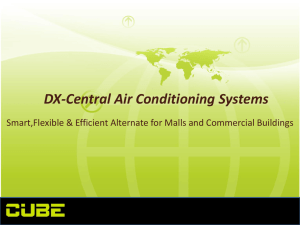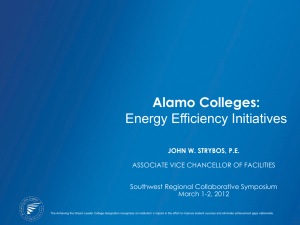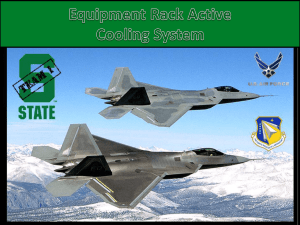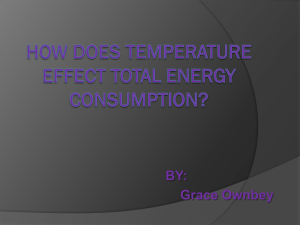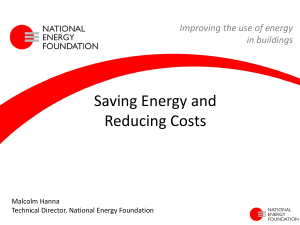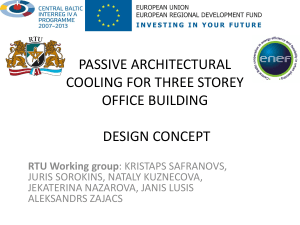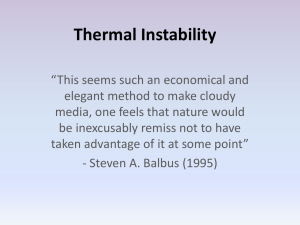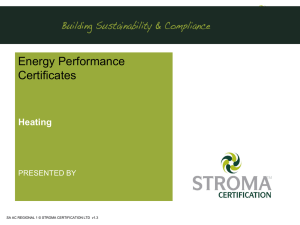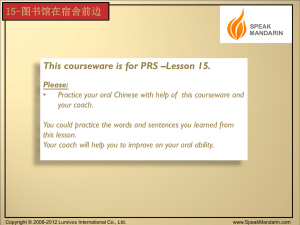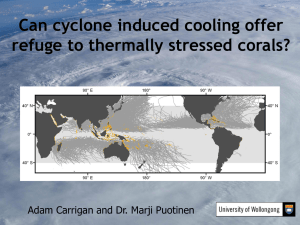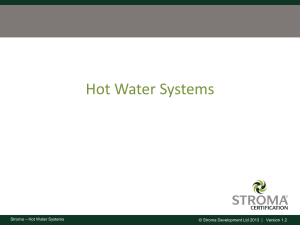6.L3 Cooling ABBE
advertisement
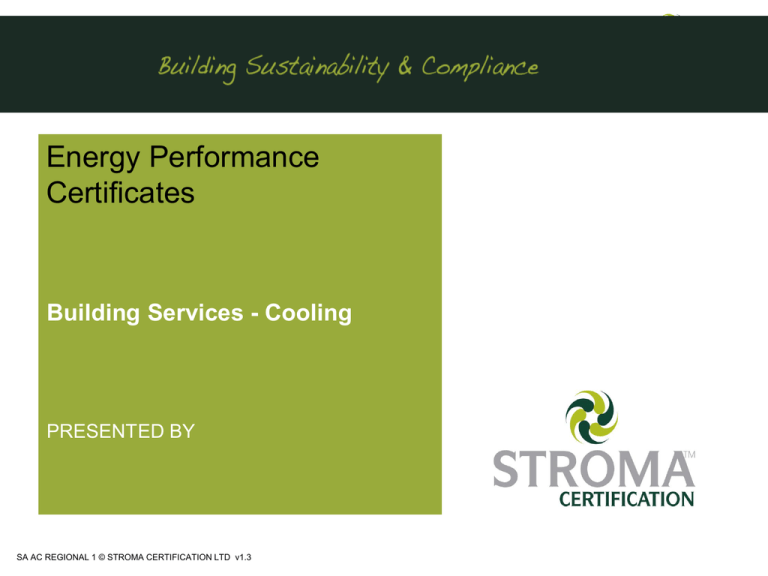
Energy Performance Certificates Building Services - Cooling PRESENTED BY SA AC REGIONAL 1 © STROMA CERTIFICATION LTD v1.3 LEVEL 3 BUILDING SERVICES TRAINING Cooling Systems Local air conditioning systems include through-the-wall packaged units and split systems to provide comfort cooling, or heating and cooling, but not humidity control. Ventilation air needs to be handled separately, and thus there is little scope for controlled free cooling. Whilst it is not common to base a major new design on individual local air conditioning units, they are commonly used to introduce air conditioning in major refurbishment of naturally ventilated buildings. Individual local units have lower CoPs than centralised plant and often lack a coherent control strategy SA AC REGIONAL 1 © STROMA CERTIFICATION LTD v1.3 LEVEL 3 BUILDING SERVICES TRAINING However, they provide scope for energy savings through: Avoiding multiple heat exchange (into/out of chilled water and condenser water) and fouling at each water heat transfer surface. Avoiding pumping large volumes of chilled and condenser water Simpler heat rejection equipment (i.e. direct air cooled condensers instead of cooling towers with their energy consumption and water treatment consequences) Plant operating only in those areas that need cooling at a given time. SA AC REGIONAL 1 © STROMA CERTIFICATION LTD v1.3 LEVEL 3 BUILDING SERVICES TRAINING Although more localised plant may increase maintenance costs, this approach may provide greater standby in areas served by a number of local units. Where it has been decided that air conditioning is unnecesary in the building as a whole, it may be appropriate to use highly localised units to cool hot spots in a mixed-mode approach, thus avoiding larger cooling systems. A similar approach may be appropriate where cooling requirements are more stringent in one small area than in the building as a whole. SA AC REGIONAL 1 © STROMA CERTIFICATION LTD v1.3 LEVEL 3 BUILDING SERVICES TRAINING Through-the-wall’ packages These units are difficult to integrate into a coherent system, but may be applicable where a single room within a building needs to be cooled, either to different temperatures, or at different times, from the remainder which has a co-ordinated system. Cooling CoP lies in the range 1.5 to 2.3. Heating is sometimes provided by electric resistance heaters, which should be appraised carefully in life cycle cost terms. Care should be taken to ensure that they do not operate in conflict with any separate space heating system, or with other similar units in the same zone, and that they are time controlled to function only when required. SA AC REGIONAL 1 © STROMA CERTIFICATION LTD v1.3 LEVEL 3 BUILDING SERVICES TRAINING • Through-the-wall’ packages SA AC REGIONAL 1 © STROMA CERTIFICATION LTD v1.3 LEVEL 3 BUILDING SERVICES TRAINING Individual reversible heat pumps Packaged heat pumps have much the same limitations as throughthe-wall packages except that heating can be provided more efficiently by reversing refrigerant flow through the indoor and outdoor coils. This saves energy in comparison with electric resistance heating, but care needs to be taken to compare the total running cost of heat from this source with other alternatives such as a separate central heating system. SA AC REGIONAL 1 © STROMA CERTIFICATION LTD v1.3 LEVEL 3 BUILDING SERVICES TRAINING Split unit packages Split units have a separate outdoor unit to house the compressor and condenser thus avoiding noise problems in the space being served. Some units offer variable speed compressors that enable cooling to be modulated, and thus the energy use can be matched more closely to cooling requirements. Split systems provide cooling CoPs of 2.5 to 3.0 whereas through the wall units only give 1.5 to 2.3. Otherwise, they should only be used in the same context as individual packaged units, with extra care taken to avoid the prospect of leaks from the connecting refrigerant lines. Most typically used in refurbishments, they often lack a coherent control strategy when multiple units supply the same space leading to simultaneous heating and cooling. SA AC REGIONAL 1 © STROMA CERTIFICATION LTD v1.3 LEVEL 3 BUILDING SERVICES TRAINING SA AC REGIONAL 1 © STROMA CERTIFICATION LTD v1.3 LEVEL 3 BUILDING SERVICES TRAINING Variable refrigerant flow rate Variable refrigerant flow rate (VRF) multi-split systems are generally regarded as local systems but are increasingly used as distributed cooling systems. More than one indoor unit can be connected to the same outdoor unit. However, it is important to comply with the manufacturer’s recommendations on horizontal pipe runs, number of bends and vertical lift, in order to minimise energy losses. In each circulation loop, the refrigerant flow rate can be varied to match the heat transport requirements, thus making energy savings. Some suppliers offer heat recovery between zones on the same circulation loop, and it is in this mode that the system operates at its peak CoP of 3.1 SA AC REGIONAL 1 © STROMA CERTIFICATION LTD v1.3 LEVEL 3 BUILDING SERVICES TRAINING In heating only, or cooling only, modes the best system CoPs lie in the range 2.3 to 2.5. In some installations, several outdoor units for individual refrigerant loops have been located in a bank adjacent to each other, but not connected, which can give the false impression of a co-ordinated system. Care should be taken to ensure a coherent control strategy with this approach. In particular, controls for multiple units serving the same space should be linked to avoid simultaneous heating and cooling. Deadbands between heating and cooling set points should be adequate to avoid individual units cycling between heating and cooling modes. SA AC REGIONAL 1 © STROMA CERTIFICATION LTD v1.3 LEVEL 3 BUILDING SERVICES TRAINING Ducted Installations Ducted split heat pump units work under the same principles as the ceiling or wall mounted units only they are located within ceiling voids or bulkheads and the conditioned air is transported to the occupied zone by means of a system of ductwork, this type of system would prove difficult to assess as all the items of plant are hidden with the only visible items of plant being grilles or diffusers. The assessor must view the installation to take records of the type of plant installed so efficiencies may be determined. Ducted units generally have a system of ventilation working alongside this installation. this may be viewed as being outside the requirements of a Level 3 assessment, however some simpler more common systems are described below.SA AC REGIONAL 1 © STROMA CERTIFICATION LTD v1.3 LEVEL 3 BUILDING SERVICES TRAINING SA AC REGIONAL 1 © STROMA CERTIFICATION LTD v1.3 LEVEL 3 BUILDING SERVICES TRAINING Other Forms of Cooling There are numerous other types of mechanical cooling available which would be outside the realms of a Level 3 assessment. The following are the most common used and are for reference purposes. • • • • • • • • • Constant volume Dual duct Variable air volume Partially centralised air/water systems Centralised air with reheat Induction Fan coils Chilled beams and ceilings Displacement ventilation SA AC REGIONAL 1 © STROMA CERTIFICATION LTD v1.3 LEVEL 3 BUILDING SERVICES TRAINING End of Section SA AC REGIONAL 1 © STROMA CERTIFICATION LTD v1.3
